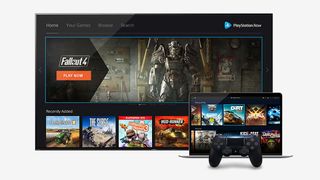PS5’s killer feature could be PlayStation Now — here’s why
PS Now on PS5 could be next-level cloud gaming

What will PlayStation Now look like on the PS5? It’s a fair question. Sony’s cloud gaming service has grown into a respectable platform over the past few years, offering hundreds of hit PS2, PS3 and PS4 games for an inexpensive monthly subscription. You can stream games, you can download games and you can even play on PC.
But when PS Now makes the generational jump, will it be content to offer the same thing, or will it expand its capabilities to compete with Google Stadia, Nvidia GeForce Now and Project xCloud?
- PS5 vs. Xbox Series X: Here's how they stack up
- Google Stadia vs. PlayStation Now vs. GeForce Now vs. Project xCloud
First off: We know that thanks to a Famitsu article (reported on by DualShockers) that PS Now will definitely be a PS5 feature. It may or may not be present at launch, but it will get there sooner or later, and continue adding games from month to month.
In its current form, there’s no denying that PS Now is a great value, and a fantastic lifeline to some of Sony’s back catalog. But there’s also so much more that PlayStation Now could offer, particularly as cloud gaming evolves from a novel curiosity into a mainstream method of game delivery. When PS Now arrives on the PS5, here’s how it can hit the ground running.
Multiple streaming platforms

Right now, the biggest problem with PlayStation Now, from my point of view, is that it’s barely compatible with anything. You can stream PS Now games on a PS4 or a PC. That’s it. In the past, PlayStation Now was also available on PS3s, PS Vitas and certain smart TVs, but Sony ended support for those systems once it became clear that people weren’t really game-streaming on them.
To be scrupulously fair, the PS4 and PC apps for PS Now work very well, and the service itself has improved tremendously since Sony decided to focus its attention on better apps for fewer platforms. (Briefly, PS Now these days is a lot more stable, responsive and full of games than it was near launch.) However, Sony also missed an opportunity to make PS Now as widely available as possible.
If you look at other streaming platforms — Stadia, GeForce Now, even the currently-in-beta Project xCloud — one thing they all have in common is platform agnosticism. If you save a Stadia game on your PC, you can pick it up minutes later on a smartphone. Just how many people are shifting constantly among TVs, PCs and smartphones is anyone’s guess, but it’s one of the primary reasons to invest in cloud gaming rather than a regular disc or download.
Sign up to get the BEST of Tom’s Guide direct to your inbox.
Upgrade your life with a daily dose of the biggest tech news, lifestyle hacks and our curated analysis. Be the first to know about cutting-edge gadgets and the hottest deals.
If Sony wants to make PS Now feel like a real next-gen streaming experience, the first thing it should do is make it available on smartphones, tablets, Sony smart TVs — maybe even other Android TV devices, like the Nvidia Shield TV. Separating the PS Now experience from a PlayStation console may seem unintuitive, and if we’re being honest, PlayStation Vue never figured out how to convince everyday users that it wasn’t just for PS4 owners. But the more places people can play PS Now, the more likely they’ll be to subscribe.
Granted, Sony may eventually want to remove PS Now functionality from PS4s, especially as those consoles age out of the everyday conversation. But as long as customers have somewhere else to continue their games, I don’t think that this will be a dealbreaker, any more than losing the PS3 app was.
PS5 games

This is a tricky one, but hear me out. I understand why Sony may not want to offer streaming PS5 games. After all, if Sony is trying to sell games à la carte, putting them on a streaming service would put Sony in competition with itself. However, there are three compelling reasons to add PS5 games to PlayStation Now as soon as possible: a) Because the latest and greatest games will be available to stream on Stadia and GeForce Now; b) Because it would get a lot of people to subscribe to the service, and c) Because Microsoft is already doing something like this.
Such a move would hardly be unprecedented for Sony. At present, PS Now has a large selection of PS4 titles, including beloved hits like Bloodborne, Persona 5 and Uncharted 4. Even system-movers like Horizon Zero Dawn and God of War (2018) have been on offer previously — although Sony inexplicably put a time limit on their PS Now availability. (Microsoft does this as well, and it’s something that both companies may have to address — although perhaps customers will grow to accept rotating contents selections, as they have with Netflix and similar streaming video services.)
Compare and contrast to Microsoft’s Xbox Game Pass. While there’s no guarantee that Game Pass and Project xCloud will ultimately work together, a fusion of the two seems like the ultimate goal for a cloud gaming setup. In Xbox Game Pass, you pay a flat monthly fee, which lets you access hundreds of games, just like PS Now. One big difference, however, is that highly anticipated Xbox games don’t come to Xbox Game Pass months after they release; they launch simultaneously. This was the case with State of Decay 2, Gears 5, Ori and the Will of the Wisps and just about every Microsoft-published game on the platform.
(The second big difference is that Xbox Game Pass requires you to download games rather than stream them. Hold that thought; we’ll come back to it.)
Whether this cuts into game profits is anyone’s guess, but offering hotly anticipated titles on release day makes people want to subscribe — and to keep their subscriptions long-term. After all, would you rather pay $60 up front for a single game, or $10 per month for as many games as you can play, including the one you were about to drop $60 on?
Conversely, consider the calculus from a company perspective: Do you want $60 of a customer’s money right now, or do you want $120 of it over the course of a year? Loyal subscribers are theoretically worth a lot more than one-and-done game buyers, and Sony would be wise to take advantage of that.
A big selection of classics

Yes, Sony should offer cutting-edge PS5 games on PlayStation Now. But if the service really wants to differentiate itself, it should also lean into the fact that it has so much classic fare on offer. I don’t think these two goals are mutually exclusive. In fact, offering older games could be the big differentiator that lets Sony stand out from the rest of the pack.
Right now, PlayStation Now offers more than 650 games. It would take too long to list even a fraction of them, but most of them (450 or so) debuted on the PS3; relatively few of them (20 or so) debuted on the PS2. None of them debuted on the PS1. This is a shame, as players love classic Sony fare, and I imagine they’d pay well for it. (Don’t let the failure of the PlayStation Classic fool you; that eschewed a lot of the system’s best games, and suffered from grievous emulation issues.)
Imagine telling gamers, “Yes, you can get the latest hit titles — and a whole library of classic Final Fantasy, Mega Man, Tony Hawk, Twisted Metal and Crash Bandicoot games.” I don’t think that would be a particularly tough sell. If adding classic games is cost-prohibitive, PS Now could always split into tiers — although whether this would be too confusing for the average user is a question worth asking.
Sony’s biggest strength has always been its game library. Leveraging some of those classic titles would be a fantastic way to differentiate PS Now from the rest of the crowd. This is particularly true since Stadia and GeForce Now can support only newer games, while Xbox wasn’t even around back when some of Sony’s most popular franchises came into being.
PlayStation Now on PS5 outlook
PlayStation Now was a promising service when it debuted, and it’s grown into one of the most solid streaming experiences on the market. Now, as the PS5, PS Now has the potential to become something special. If Sony expands platform availability, ensures parity in new releases and takes advantage of its back catalog, this cloud gaming service could offer features that no other streaming platform has at its disposal.
And who knows? If it succeeds, then Sony could become a victim of its own success. A world with a perfect game-streaming platform leaves precious little room for standalone consoles.
Marshall Honorof is a senior editor for Tom's Guide, overseeing the site's coverage of gaming hardware and software. He comes from a science writing background, having studied paleomammalogy, biological anthropology, and the history of science and technology. After hours, you can find him practicing taekwondo or doing deep dives on classic sci-fi.

